[English] 日本語
 Yorodumi
Yorodumi- PDB-3iy4: Variable domains of the computer generated model (WAM) of Fab 15 ... -
+ Open data
Open data
- Basic information
Basic information
| Entry | Database: PDB / ID: 3iy4 | ||||||
|---|---|---|---|---|---|---|---|
| Title | Variable domains of the computer generated model (WAM) of Fab 15 fitted into the cryoEM reconstruction of the virus-Fab 15 complex | ||||||
 Components Components |
| ||||||
 Keywords Keywords | IMMUNE SYSTEM / cryoEM / neutralizing antibody / parvovirus / canine / feline / fab footprint | ||||||
| Biological species |  | ||||||
| Method | ELECTRON MICROSCOPY / single particle reconstruction / cryo EM / Resolution: 11.7 Å | ||||||
 Authors Authors | Hafenstein, S. / Bowman, V.D. / Sun, T. / Nelson, C.D. / Palermo, L.M. / Chipman, P.R. / Battisti, A.J. / Parrish, C.R. / Rossmann, M.G. | ||||||
 Citation Citation |  Journal: J Virol / Year: 2009 Journal: J Virol / Year: 2009Title: Structural comparison of different antibodies interacting with parvovirus capsids. Authors: Susan Hafenstein / Valorie D Bowman / Tao Sun / Christian D S Nelson / Laura M Palermo / Paul R Chipman / Anthony J Battisti / Colin R Parrish / Michael G Rossmann /  Abstract: The structures of canine parvovirus (CPV) and feline parvovirus (FPV) complexed with antibody fragments from eight different neutralizing monoclonal antibodies were determined by cryo-electron ...The structures of canine parvovirus (CPV) and feline parvovirus (FPV) complexed with antibody fragments from eight different neutralizing monoclonal antibodies were determined by cryo-electron microscopy (cryoEM) reconstruction to resolutions varying from 8.5 to 18 A. The crystal structure of one of the Fab molecules and the sequence of the variable domain for each of the Fab molecules have been determined. The structures of Fab fragments not determined crystallographically were predicted by homology modeling according to the amino acid sequence. Fitting of the Fab and virus structures into the cryoEM densities identified the footprints of each antibody on the viral surface. As anticipated from earlier analyses, the Fab binding sites are directed to two epitopes, A and B. The A site is on an exposed part of the surface near an icosahedral threefold axis, whereas the B site is about equidistant from the surrounding five-, three-, and twofold axes. One antibody directed to the A site binds CPV but not FPV. Two of the antibodies directed to the B site neutralize the virus as Fab fragments. The differences in antibody properties have been linked to the amino acids within the antibody footprints, the position of the binding site relative to the icosahedral symmetry elements, and the orientation of the Fab structure relative to the surface of the virus. Most of the exposed surface area was antigenic, although each of the antibodies had a common area of overlap that coincided with the positions of the previously mapped escape mutations. | ||||||
| History |
|
- Structure visualization
Structure visualization
| Movie |
 Movie viewer Movie viewer |
|---|---|
| Structure viewer | Molecule:  Molmil Molmil Jmol/JSmol Jmol/JSmol |
- Downloads & links
Downloads & links
- Download
Download
| PDBx/mmCIF format |  3iy4.cif.gz 3iy4.cif.gz | 52.6 KB | Display |  PDBx/mmCIF format PDBx/mmCIF format |
|---|---|---|---|---|
| PDB format |  pdb3iy4.ent.gz pdb3iy4.ent.gz | 40.2 KB | Display |  PDB format PDB format |
| PDBx/mmJSON format |  3iy4.json.gz 3iy4.json.gz | Tree view |  PDBx/mmJSON format PDBx/mmJSON format | |
| Others |  Other downloads Other downloads |
-Validation report
| Summary document |  3iy4_validation.pdf.gz 3iy4_validation.pdf.gz | 674.1 KB | Display |  wwPDB validaton report wwPDB validaton report |
|---|---|---|---|---|
| Full document |  3iy4_full_validation.pdf.gz 3iy4_full_validation.pdf.gz | 705.5 KB | Display | |
| Data in XML |  3iy4_validation.xml.gz 3iy4_validation.xml.gz | 19.5 KB | Display | |
| Data in CIF |  3iy4_validation.cif.gz 3iy4_validation.cif.gz | 26.1 KB | Display | |
| Arichive directory |  https://data.pdbj.org/pub/pdb/validation_reports/iy/3iy4 https://data.pdbj.org/pub/pdb/validation_reports/iy/3iy4 ftp://data.pdbj.org/pub/pdb/validation_reports/iy/3iy4 ftp://data.pdbj.org/pub/pdb/validation_reports/iy/3iy4 | HTTPS FTP |
-Related structure data
| Related structure data |  5109MC  5105C  5106C  5107C  5108C  5110C  5111C  5112C 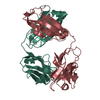 3gk8C  3iy0C  3iy1C  3iy2C  3iy3C  3iy5C  3iy6C  3iy7C M: map data used to model this data C: citing same article ( |
|---|---|
| Similar structure data |
- Links
Links
- Assembly
Assembly
| Deposited unit | 
|
|---|---|
| 1 |
|
- Components
Components
| #1: Antibody | Mass: 11970.164 Da / Num. of mol.: 1 / Fragment: fragment of neutralizing antibody 15 / Source method: isolated from a natural source / Source: (natural)  |
|---|---|
| #2: Antibody | Mass: 12367.916 Da / Num. of mol.: 1 / Source method: isolated from a natural source / Source: (natural)  |
-Experimental details
-Experiment
| Experiment | Method: ELECTRON MICROSCOPY |
|---|---|
| EM experiment | Aggregation state: PARTICLE / 3D reconstruction method: single particle reconstruction |
- Sample preparation
Sample preparation
| Component |
| |||||||||||||||
|---|---|---|---|---|---|---|---|---|---|---|---|---|---|---|---|---|
| Details of virus | Empty: NO / Enveloped: NO / Host category: VERTEBRATES / Isolate: STRAIN / Type: VIRION | |||||||||||||||
| Natural host | Organism: Felis catus | |||||||||||||||
| Virus shell | Triangulation number (T number): 1 | |||||||||||||||
| Buffer solution | pH: 7.5 / Details: 10mM Tris-HCL | |||||||||||||||
| Specimen | Conc.: 1 mg/ml / Embedding applied: NO / Shadowing applied: NO / Staining applied: NO / Vitrification applied: YES / Details: 10mM Tris-HCL | |||||||||||||||
| Vitrification | Instrument: HOMEMADE PLUNGER / Cryogen name: ETHANE / Temp: 120 K / Method: blot before plunging |
- Electron microscopy imaging
Electron microscopy imaging
| Microscopy | Model: FEI/PHILIPS CM300FEG/T / Date: Mar 29, 2004 |
|---|---|
| Electron gun | Electron source: TUNGSTEN HAIRPIN / Accelerating voltage: 300 kV / Illumination mode: FLOOD BEAM |
| Electron lens | Mode: BRIGHT FIELD / Nominal magnification: 45000 X / Calibrated magnification: 47190 X / Nominal defocus max: 3.4 nm / Nominal defocus min: 0.9 nm Astigmatism: astigmatism was corrected at 100,000 times magnification Camera length: 0 mm |
| Specimen holder | Specimen holder model: GATAN LIQUID NITROGEN / Specimen holder type: side mounted nitrogen cooled / Temperature: 93 K / Temperature (max): 83 K / Temperature (min): 83 K / Tilt angle max: 0 ° / Tilt angle min: 0 ° |
| Image recording | Electron dose: 34.52 e/Å2 / Film or detector model: KODAK SO-163 FILM |
| Image scans | Sampling size: 7 µm / Num. digital images: 50 / Od range: 0.9 / Scanner model: ZEISS SCAI |
| Radiation | Protocol: SINGLE WAVELENGTH / Monochromatic (M) / Laue (L): M |
| Radiation wavelength | Relative weight: 1 |
- Processing
Processing
| EM software |
| ||||||||||||
|---|---|---|---|---|---|---|---|---|---|---|---|---|---|
| CTF correction | Details: robem | ||||||||||||
| Symmetry | Point symmetry: I (icosahedral) | ||||||||||||
| 3D reconstruction | Method: common lines / Resolution: 11.7 Å / Resolution method: FSC 0.5 CUT-OFF / Num. of particles: 4798 / Symmetry type: POINT | ||||||||||||
| Refinement step | Cycle: LAST
|
 Movie
Movie Controller
Controller


 UCSF Chimera
UCSF Chimera

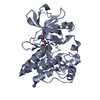

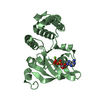
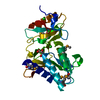

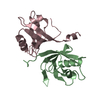

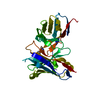
 PDBj
PDBj



